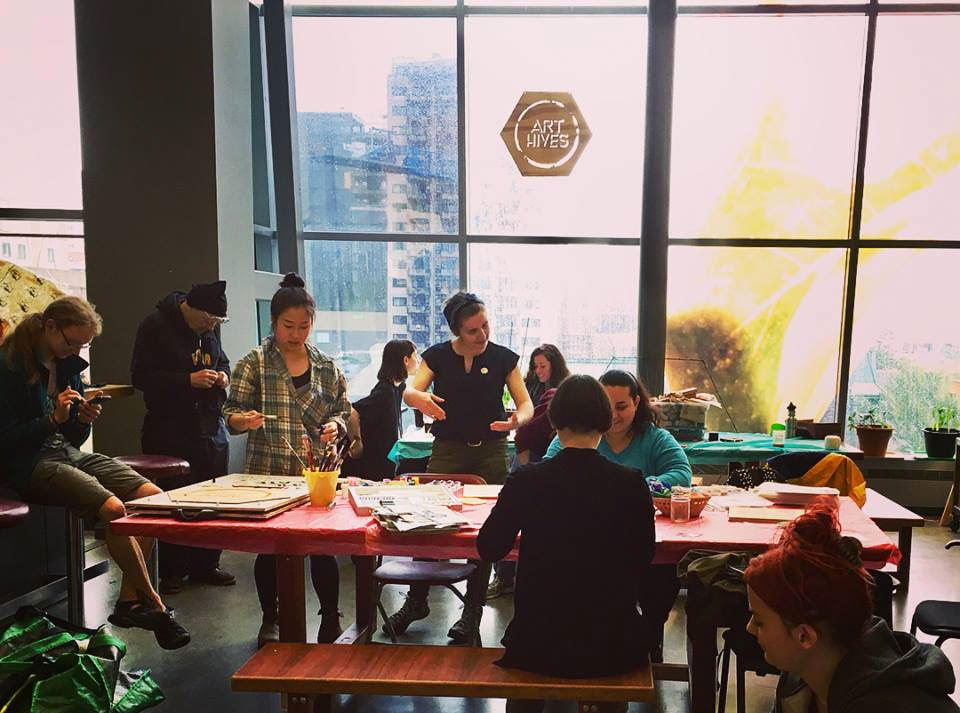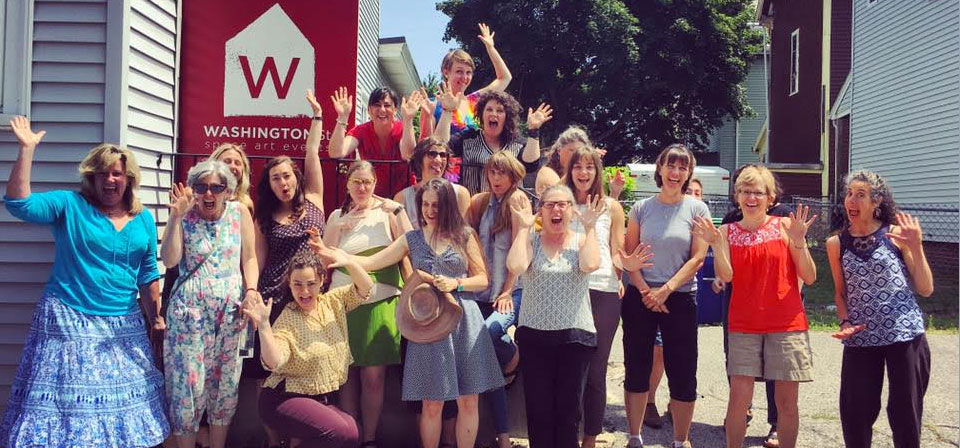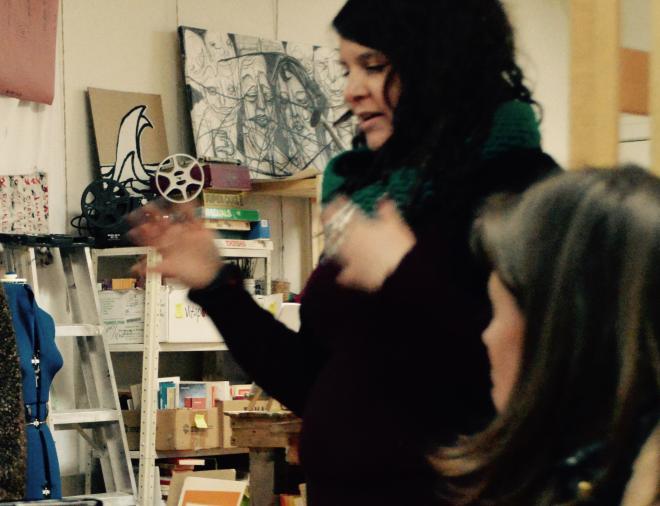
La maison des ruches d’art est localisée au sein du département des Beaux-arts de l’Université Concordia. Ce laboratoire vivant joue le rôle d’ épicentre dynamique dans lequel les activités de consultation, d’éducation, de recherche , de co-développement et d’innovation sociale contribuent au développement et la pérennité du réseau des ruches d’art ainsi qu’à la pollinisation des pratiques publiques d’art thérapie - terme initié par la fondatrice des ruches d’art, Dr. Janis Timm Bottos.
Pour nous joindre
La maison des ruches d’art
Université Concordia
Complexe d’ingénierie et d’arts visuels intégrés
1515 rue Sainte-Catherine Ouest, EV5. 779
Montréal, QC
Canada H3G 2W1
Nos activités
Consultations personnalisées pour les ruches d’art existantes et à venir
Notre équipe offre des services de consultations personnalisées destinés aux individus et aux organisations qui développent une ruche d’art ou souhaitent en créer une. La première heure de consultation est gratuite.
Contactez-nous pour prendre un rendez-vous en personne ou par vidéo conférence.
Les rencontres des ruches d’art
Les ruches d’art de Montréal se réunissent une fois par mois pour échanger et partager leurs connaissances sur les thématiques qu’elles ont en commun – ex : la gestion de conflits, l’accompagnement des participants avec des besoins particuliers, la recherche de financements, la communication etc.
L’ Institut des ruches d’art
L’institut des ruches d’art correspond à quatre jours expérientiels intensifs d’enseignement de la théorie, des méthodes et outils pour créer des espaces inclusifs qui contribuent à la construction de communautés à travers la pratique des arts, le dialogue et le partage de savoir-faire.
Le cours est dispense par Janis Timm-Bottos, professeure d’art thérapie à l’université Guy Concordia et Rachel Chainey, coordinatrice du réseau national des ruches d’art, art-thérapeute et entrepreneure sociale, en collaboration avec plusieurs facilitateurs de ruches d’art. Ce cours a été conçu pour des professionnels oeuvrant déjà dans des ruches existantes ou pour des personnes sérieusement intéressées par créer ce type de tiers-espaces. Le cours alterne entre la couverture d’ aspects pratiques et théoriques et une multitude de moments de partage de savoir-faire, d’échanges, de visites de sites et de création en contexte.
Aucun pré-requis n’est nécessaire pour ce cours. Une expérience préalable dans un studio d’art communautaire serait néanmoins appréciée.
Au terme de ces quatre jours, les participants repartent avec :
- Un nouveau réseau de collègues passionnants, de nouveaux savoir-faire, outils de création artistiques ainsi que de nouvelles idées.
- An Une vision globale des différents modèles de ruches d’art possibles (structures légales, modèles organisationnels) et des possibilités pour donner vie et pérenniser un projet de ruche.
- Une compréhension approfondie des valeurs, de la philosophie et des sources d’inspirations historiques des ruches d’art ainsi que des impacts de ces tiers-lieux artistiques sur les individus et les communautés.
Vous aimeriez une formation sur mesure sur l’approche des ruches d’art dans votre communauté ? Contactez-nous !
Le ‘’Studio d’art communautaire : Méthodes et outils’’, cours crédité par l’université Concordia
Enseignant : Dr. Janis Timm-Bottos
Département d’art thérapie
Merci de contacter le département pour vous inscrire
Ce cours expérientiel est donné par le professeur associé, Dr Janis Timm-Bottos (art thérapeute) à la Ruche d’art Saint-Henri, accueillant tiers-lieu artistique favorisant l’inclusion sociale et le renforcement des liens au sein de la communauté. Ce cours annuel, offert depuis 2011, attire des étudiants de plusieurs départements universitaires, incluant les départements d’art thérapie, de musique, théâtre, urbanisme, enseignement des arts, anthropologie, philosophie. Ce cours est conçu pour accueillir à la fois des étudiants universitaires - qu’ils aient gradué ou non dans leur discipline – et des étudiants indépendants, oeuvrant dans la communauté.
L’apprentissage pratique et la pratique de l’art sont intégrés à chaque étape de ce cours. En plus de la connection avec les membres de la communauté au sein du studio, les étudiants doivent compléter quinze heures de stage dans d’autres ruches d’art du réseau. Ces espaces, qui partage les mêmes valeurs de gratuité et d’accessibilité inhérentes à chaque ruche d’art sont aussi très diversifiés : centres sociaux, parcs, coopératives, résidences pour ainés, bibliothèques, organismes communautaires, centres des femmes, écoles, musées… Dans chaque installation, les étudiants mettent en pratique les approches non interventionnistes qui sont au cœur du modèle des pratiques publiques d’art-thérapie présentes dans les ruches d’art : observation, partage de savoir-faire de manière informelle et horizontale selon le principe que ‘’chacun apprend à l’autre’’, création de lien social au sein de chaque lieu public (Belenky, 1996) et apprentissage de ‘’l’éthique de l’inconfort’’ (Foucault, Rabinow, 1994)
Ancrée dans la psychologie de la libération (Watkins & Shulman, 2008), les pratiques publiques d’art thérapie telle que développées à l’Université Concordia invitent tous les étudiants à examiner leur propre position dans la société en lien avec les notions de privilège, de pouvoir, de dynamiques oppressives du colonialisme et de gentrification qui peuvent exister dans leurs communautés respectives. A travers ce cours, les étudiants embarquent dans un voyage par lequel ils vont creuser leur compréhension de ces concepts et leurs relations personnelles avec eux par le biais de la création artistique et la prise de notes sur le terrain. Le cours s’achève par une présentation publique des projets finaux des étudiants, devant des membres de la communauté, des partenaires académiques et financiers.
La cohorte 2017 a été invitée à analyser les effets du colonialisme en participant à des cercles d’écoute dans des ruches d’art, inspirés du livre ''Unsettling the Settler Within'' (Regan, 2010) et à travers l’exercice des couvertures (https://www.kairosblanketexercise.org/). La classe a ensuite créé des œuvres sur le thème de la réconciliation et partagé leurs histoires personnelles en lien avec ce sujet durant une présentation publique mais également sous forme d’articles de blog partagé sur ce site.
Lauréats Des Bourses Étudiantes Pour Des Stages En Ruches D’art Pour L’été Et L’automne 2018
Les bourses pour des stagiaires au sein de ruches d’art sont fournis gracieusement par la Fondation J.A De Sève. Les étudiants en art thérapie de l’université Concordia sont invités à proposer un stage et/ou une idée de projet de recherche pour répondre aux besoins et intérêts d’une ruche d’art située dans un lieu ou une institution au Québec Ces opportunités permettront aux étudiants de développer des compétences pratiques pertinentes pour leur carrière et de mettre en application leur apprentissage par le biais d’un engagement pratique avec le public, tout en développant des liens dans la communauté et mesurant leur impact sur le terrain. De la supervision sera fourni par une art-thérapeute membre de l’Ordre si besoin.


